Bookinng #
— desirable room booking service for Innopolis University
👉 Presentation 👈 #
- Check out our slides (PDF)
/ [pdf]
- Come to the room #314 on 19th of July
- Try our BETA-release (TBA)
Week 1 #
Team formation and project proposal
Team Members #
| Member | Telegram | |
|---|---|---|
| Vladislav Deryabkin (Lead) | evermake | v.deryabkin@innopolis.university |
| Yaroslav Kivaev | catdog905 | k.yaroslav@innopolis.university |
| Ekaterina Koshmanova | k_koshmann | e.koshmanova@innopolis.university |
| Vadim Zbarashchenko | metafates | v.zbarashchenko@innopolis.university |
| Ruslan Bakirov | monyter | r.bakirov@innopolis.university |
| Anton Skorkin | PozhiloyProger | a.skorkin@innopolis.university |
Value Proposition #
The Problem #
Innopolis University offers students and employees the opportunity to book rooms for personal use through the my.university.innopolis.ru website. While this service is appreciated, there are several issues with the current process of rooms booking that need to be addressed.
Currently, users must select a specific room and check its calendar for availability. If a time slot is free, they can book the room by creating an event in the calendar. This system is convenient if the user knows exactly which room they want to book or if most rooms are available. However, when students need a free room for a specific time slot they must check the schedule of every room which can be time-consuming and frustrating.
Another related problem that we observe is that students and employees often struggle to physically locate specific rooms, auditoriums, and offices in the university building.
To justify the problems and make sure we are not the only one who have troubles, we conducted a survey with 26 participants (excluding those who do not book rooms and our team members). The results showed that:
- Students in general actively use the rooms booking service.
- More than a half of participants spend more than 5 minutes on average to choose and book a room.
- Participants are generally dissatisfied with the usability of the current system. Furthermore, none of the participants rated the system’s convenience as a five out of five.
- Two-thirds of the participants would very much like to be able to see rooms available at a selected time interval, while a quarter found it to be a good idea. Almost the same for the ability to see available time slots for a specific room.
- Over half of participants would appreciate a visual view of the room layout while booking.
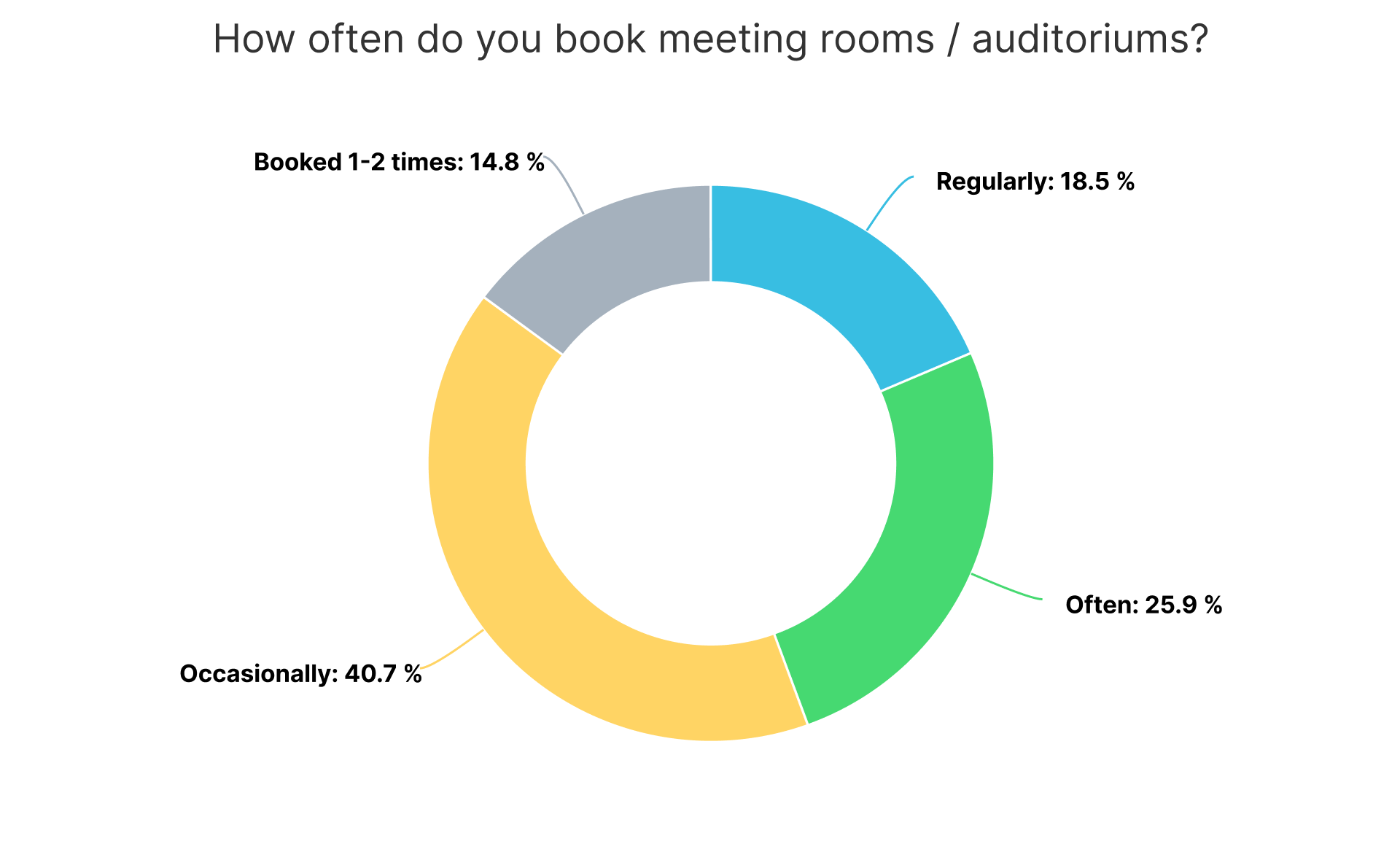
You can find the complete survey results in the attached PDF file:
Solution #
Both of the problems listed above can be solved by a service that provide a convenient interface for choosing an available room in the university and a map of each floor. User can check available rooms for a specific time, entering period of time and see free rooms at this time on the graphical map (where free and booked rooms will look differently helping a user to find an appropriate room). Grouping all free room entering specific time helps to quickly find a room within a specific time period. Also this service helps to get the position of rooms in Innopolis University building having its name/number.
Benefits To Users #
Time saving is the most valuable outcome for users from our service. We expect these things to happen after we finish the project:
- Users will not have to scramble through the rooms to find a free one for the desired time slot;
- Users will find a free time slot for the selected room faster as this will be done in a more convenient way;
- Users will not run around a minute before the meeting to look for a room, as they will see the room locations on the map at the time of booking;
- An overall user experience will be improved by making the process of the events planning more pleasant.
Uniqueness #
The proposed (tentative) system is better than the existing Microsoft Outlook solution of room booking in different aspects:
- It provides extra functionality for finding an available room;
- It will show a visual representation of rooms location to help users find rooms;
- It will have a mobile-friendly interface to simplify the booking process using a phone, which is usually most often at the fingertips of people.
One of our optional goals is to make the process of adding new building map easily, that can make this project useful for others companies and took it to commercial level.
User Impact #
We believe that successful solution will not only improve users experience and their productivity but also will highly affect on the university’s ecosystem level. Such unique solutions make ecosystem more innovative and underline the IT technologies in our university.
User Testimonials or Use Cases #
Use case of a building map — many shopping malls provides a digital map of the building with description and navigation to specific shops that helps customers locate different facilities. But these solutions usually implemented using stationary displays. Another drawback of existing solutions is that they are not globalized.
Lean Startup Questionnaire #
1. What problem or need does your software project address?
The primary problem our project addresses is the inconvenience of the rooms booking process in Innopolis University.
2. Who are your target users or customers?
Our target users are the university students and employees who take advantage of the rooms booking service.
3. How will you validate and test your assumptions about the project?
We will give an opportunity to the users to try our MVP version’s and test our assumptions by measuring the performance and considering overall feedback. After that we will analyze the results and make decisions abou the testes assumptions.
4. What metrics will you use to measure the success of your project?
We are going to make another survey similar to the mentioned above and make sure that performance has improved, users are happy with the interface and spend a minimum of time searching and booking rooms. We will collect the following metrics to evaluate our success:
- Amount of reduction of the average booking time of a room;
- Positive feedback from users — how much are they satisfied with the interface and performance of our system.
5. How do you plan to iterate and pivot if necessary based on user feedback?
We will see the main complaining points, ask for ideas from users and generate new solutions for these tasks. After that we will try to implement the best ones and once again give it for testing to users.
Leveraging AI, Open-Source, and Experts #
Artificial Intelligence #
Our team plans to use LLM code generation (GitHub Copilot) to make the process of development faster, especially working with Outlook Calendar API, that is, AI will help us find relevant API endpoints and their response schemas quicker, than browsing documentation ourselves.
We are also considering incorporating AI-powered features in our system that will require use of AI, such as suggesting the best place and time for a meeting based on a user’s preferences and predicting room occupancy at different times to help users make better decisions when booking a room.
Open-Source #
First of all, we are going to use open-source libraries and frameworks during development. Particularly, for frontend part we are going to use either Vue.js or React.js framework; for backend we will use one of the most popular frameworks (Django or FastAPI for Python, Spring for Java), but it depends on the programming language and stack we will agree on.
Secondly, we will also open-source all our code, which is not intended to be private and may be useful for others.
Experts in Relevant Domains #
We have reached out to the individual involved with Innopolis current room booking system. They have given their approval for our proposal and will be available to assist us whenever any issues arise.
Inviting Other Students #
We found out that there is a group of first year students who are working on a Software Project to create a Telegram bot for rooms booking. We have contacted them and plan to discuss combining our projects to add a Telegram bot to the system. If we will agree to work together, we can get the project done faster and better.
Vision Of The Project #
Overview #
We want to create a service for convenient booking rooms. A lot of people have difficulties with finding rooms, checking accessibility of a rooms and finally booking them. Our project will try to solve these problems.
Schematic Drawings #
We do not have a clear understanding of which components will we have in our system and how will they communicate, but we can share our our current view of what the system’s core components may look like on the diagram:
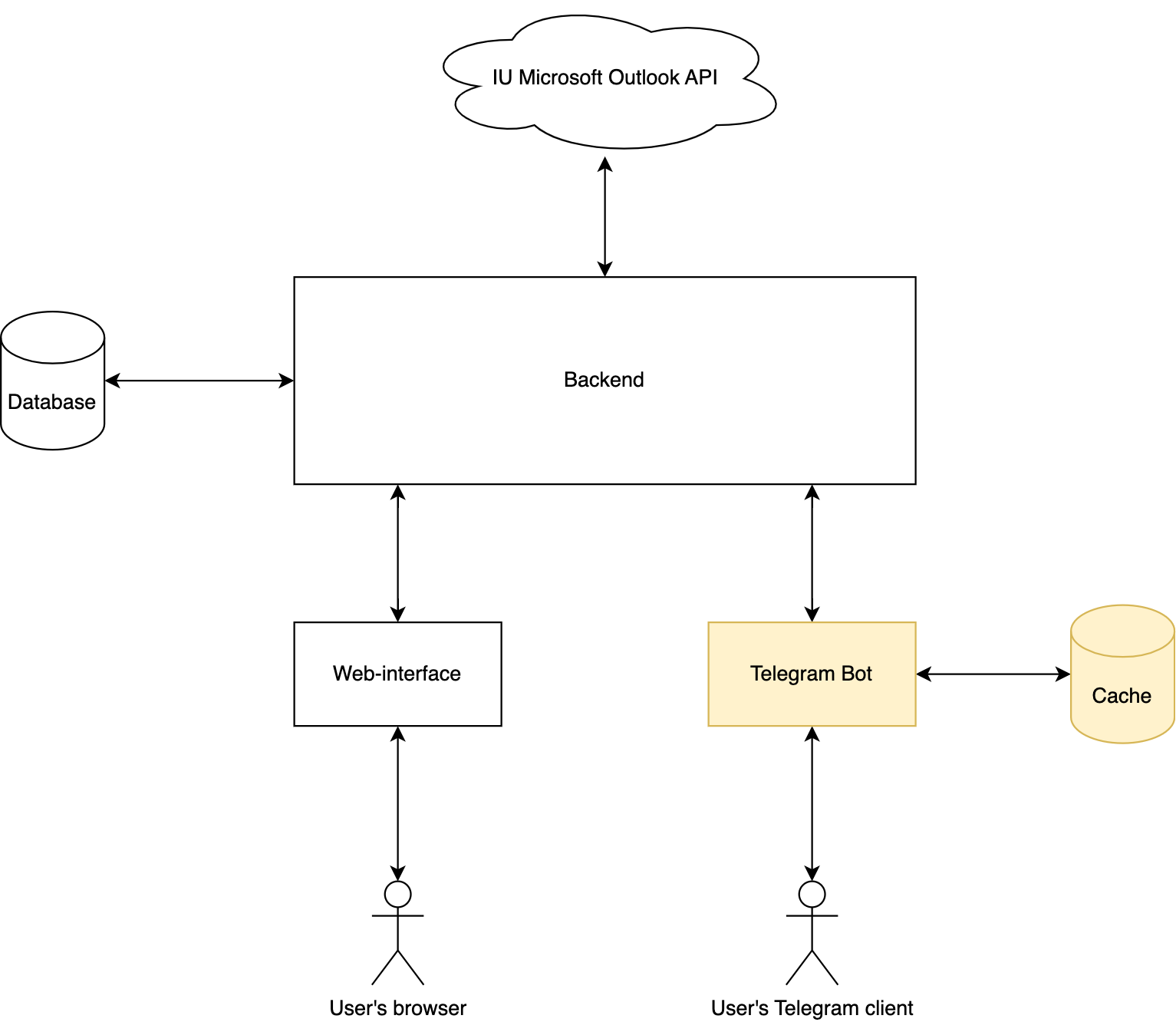
There are two core parts:
- Backend — responsible for handling booking requests and managing database operations.
- Web-interface — user-facing aspect of the project, what the user will see and interact with.
Additionally, we are considering incorporating a Telegram Bot as an optional feature, but we have not yet decided whether to implement it or to ask for help from first-year students for its development.
Tech Stack #
We have not yet decided about our stack, but we have some ideas. For frontend part we are going to use either Vue.js or React.js framework; for backend we will use one of the most popular frameworks (Django or FastAPI for Python, Spring for Java).
It is very likely that we will use some kind of data storage. We plan to use Postgres as a DBMS and/or Redis for caching.
Anticipating Future Problems #
We see 2 primary problems we can face in the future:
- Obtaining the map of the university and making the interactive digital copy of it. If this task turns out to be too complicated and time-consuming, we plan to implement it in a simpler way, such as using static photos to help people locate the rooms.
- Finding a way to integrate our system into the life of the university, as this will most likely require working with the Microsoft Outlook API. To solve this problem we are going to consult with people in university who are responsible for My University portal or can give us advice.
Elaborate Explanations #
For now we do not have a clear vision of components that make up our system and their relations. But the core parts we are going to implement are the following:
- Backend that utilizes currently used Outlook API to provide a better interface for rooms booking;
- Mobile-friendly interface with focus on usability and simplicity;
- Digital map or other way to help users find rooms location.
Feedback
Value Proposition Very nice details and approach. Although we previously had an opportunity to book rooms though calendar in outlooks and it was very convenient. It will check which free rooms available at the desired time.
Also, the university does have a map to tell which room and where is it. You can contact me to sent it to you.
Lean startup question
- Only positive feedback? Why :) negative feedback is important also
AI I hardly see AI application in your product
Vision Of The Project One very easy way to tell people where is meeting room. Is to tell them they are located next to what rooms? Or maybe give description how to reach by description the road to take.
Overall Very good report! But try to think more about AI utilizing. 5/5
Feedback by Moofiy
Week 2 #
Choosing the tech stack, designing the architecture
Tech Stack Selection #
After discussing the possibility of incorporating our project into the Innopolis University’s current room booking service with Andrey Markov, who developed the current active service, we identified two constraints on our backend that would need to be addressed:
- We MUST use Microsoft Outlook API to actually book rooms — this enables us to integrate our project into the university’s life without a need of introducing changes to the current infrastructure;
- We MUST use a well-known programming language with a popular framework — this is required so that in the future it will not be difficult to find developers who can easily make changes to our code-base.
Following discussions with Andrey and the team, we concluded that Python would be the ideal programming language for our backend, with FastAPI as our web-framework. This decision was based on the following factors:
- Firstly, Python — is one of the most popular programming languages;
- Secondly, FastAPI — is one of the most popular web-frameworks for Python and it is actively maintained by the open-source community;
- Finally, exchangelib — is one of the few actively maintained libraries for working with Microsoft Outlook API (which is crucial in our case) with the good API and documentation, and which is written in Python.
We also decided not to implement Telegram Bot ourselves, since we don’t have enough resources for that, and, moreover, there are already several groups of first-year students who are already working on it.
Our frontend application will be written in Next.js —powerful and very popular open-source web framework, which has a great documentation and a large community. Also, it will not take much effort to start working with it, as our team members have experience working with React, and Next.js is based on React. Moreover, Next.js provides an SSR (server-side rendering), which will have a good impact on the performance and security of our application.
We’re going to setup automated Docker images building process for our backend and frontend. This will allow us easily deploy them on any VPS, which more likely will be provided by the university, when we finish the project. But for now, we are going to deploy frontend on GitHub Pages or other free static-assets hosting solutions. We also plan to use Kubernetes to orchestrate our Docker containers to achieve high fault-tolerance.
Speaking of CI/CD we will use GitHub Actions configured with code linters and test runners to protect the main branch from unexpected bugs and to enforce the same coding style along all team members. We decided to use GitHub Actions because it’s the most approachable tool for our repositories that are hosted on GitHub.
To conclude, our tech stack is the following:
- Backend
- Python + FastAPI + SQLAlchemy
- Redis
- PostgreSQL
- Docker
- Frontend
- TypeScript + Next.js
- Docker
- CI/CD — GitHub Actions
Architecture Design #
Component Breakdown #
The end user will interact with the frontend part, which will communicate with our backend.
Frontend part is the web interface with interactive university map, which user can utilize in order to locate rooms and choose them for booking.
Backend part implements an API, that hides the complexity of Outlook API and exposes some method for searching and booking rooms. The API will have identification and authentication via SSO for students.
Data Management #
Basically, Outlook server stores all information about room’s schedules, but we suffer from lack of methods in Outlook API, so other caching technique on our side may be applied. For example, presumably, every time when we want to get all free rooms for specified time period, we have to request schedule of each room separately. Obviously, that increases latency of the whole operation. To solve this problem we are going to employ two techniques:
- Reliability via redundancy. We are going to query bigger period of time that user request in order to avoid duplicate request to Outlook API if user will make a small change of time period.
- Caching. We will cache all schedules that goes through our API in order to reduce amount of redundant requests to Outlook server. Sometimes our API will refresh the whole information from Outlook server in order to get room booking changes that was made by aside instruments. We are going to use Redis as our cache.
We will also need to store some information about user’s (to validate API tokens, for example), this will be stored in PostgreSQL database and accessed using SQLAlchemy framework in the code. PostgreSQL is our choice, because it is an open-source and performant DBMS, and, moreover, most of the team members have an experience of working with it.
User Interface (UI) Design #
See our UI design drafts.
Scalability and Performance #
Currently the number of supposed clients for our application is not high, but we definitely consider possibility of scaling. We have three objects of scaling:
- API application
- Redis database
- Outlook server
The first one, API application, we can scale in Kubernetes increasing the number of pods for the deployment. Obviously, we will need some software load balancer in order to multiplex the traffic. We will choose it later, when the problem of scaling come.
Redis database can be scaled using it’s partitioning mechanism.
And the most problematic part of scaling for us is Outlook server. If the problem appears we will first contact with university IT department to resolve the problem before planning scaling.
Security and Privacy #
All API requests to our system will be protected with the FastAPI middleware. Before accessing the system, a user will be required to authenticate in the Innopolis SSO, which is used in all online-tools that students use every day. After confirming the user’s identity, our backend will generate a JWT token, which will be send with every request (via header or cookie) from our frontend app. Therefore, user will be able to log in only if it has a valid token, which can only be obtained from a database that only the backend will have access to.
Error Handling and Resilience #
We are going to add metrics for each request in API and log all improtant information in our code and use basic functionality of k8s platform for restarting the application in case of failure and getting logs from a pods.
Deployment and DevOps #
We utilize GitHub Actions to automate the process of type-checking, linting code, validating code-style, running tests and building Docker images.
We are going to deploy our backend application to kubernetes cluster, which solves a huge amount of problems of orchestration.
We also protected our main branches from direct commits and establish rules for making commits and PRs, which will allow us to keep the history clean and automatically generate changelogs.
UI Design Drafts #
For now we plan to have only 3 main screens in our web-application.
Authentication #
Before booking a room, a user need to authenticate in our service. We think that it will be enough to have a single “Login” button, which will redirect the user to the Innopolis SSO page.

Booking a Room #
When authorized, the user will see the main booking screen, where it can choose date and time for a new event, specify a title, and see all available rooms on the map of the 3rd floor.

TV-screen Dashboard #
We also want to use the TVs that are located outside the rooms to provide useful information to students and staff who pass near the room and want to know about the current event that is going on in the room and get a general idea of the current schedule of this room. We received a useful feedback during the first week from students, where they talked about current problems with displaying time and other data, and also offered interesting ideas about what they would like to see on these screens.

So far, we have only managed to develop a calendar design that will be visible on the TV, but we are still thinking about what the most important information should be visible on TVs and how it can be displayed in the most convenient way for user’s perception.
Of course, these are just the wireframes, and the actual design will be consistent with the Innopolis University’s infrastructure and be user-friendly. We arere hardly working on making it minimalistic and intuitively useful for our users.
Week 2 Questionnaire #
1. Tech Stack Resources
Our team members are actively developing and pumping up their skills by completing online courses and reading classic literature in our field.
This way we get acquainted with the experience of other successful developers and fill the cones ourselves.
2. Mentorship Support
- We communicate with Andrey Markov, he will help us in case of difficulties with creating a booking API (backend).
- We can contact developers of open-source tools we participated in developing of which in public Telegram groups.
3. Exploring Alternative Resources
We feel comfortable with our tech stack and we have the great resources that we hope will fill all the gaps we will encounter during the development process:
- Next.js documentation
- FastAPI documentation
- Docker documentation
- exchangelib documentation for working with Microsoft Outlook API
- MDN Web Docs as a JavaScript reference
4. Identifying Knowledge Gaps
Overall, our team consist of several people. And aggregation of their skills and knowledge cover all necessary fields of our project. However, we can highlight several point of development where our experience is weak:
- DevOps
- QA
We don’t consider this a big problem, and if these weaknesses will raise some issues, we have a lot of resources and smart developers in the university to resolve the problems. As a last resort, we can get support and ready-made code templates from language models like ChatGPT.
5. Engaging with the Tech Community
We consulted with development department in Innopolis University and agreed that we are going to use and that is suitable for them for further maintenance. We also have an experience to work with our tech stack in real-world projects maintained by experts, so we can contact them when we need an advice.
6. Learning Objectives
Obtaining experience of working with our tech stack and experience of working as a team is the main goal of our project. To achieve this goal we … (see next question).
7. Sharing Knowledge with Peers
Currently, we have several chats, where we share our knowledge about different fields:
- Backend
- Frontend
- DevOps
We also a have a common Notion workspace, where we create guides and collect all information and resources we found to be useful.
8. How have you leveraged AI to compensate for any lacking expertise in your tech stack?
We use ChatGPT and GitHub Copilot to increase the code-writing speed and to save time on reading documentation and searching for frequently used pieces of code on the Internet.
Team Allocation #
- Vladislav Deryabkin is responsible for managing the project execution, designing the system architecture, uploading weekly reports on time, helping with writing code for frontend and backend, making sure each team member actively works on his task and receives support in case of any difficulty.
- Yaroslav Kivaev is responsible for DevOps, helping with Docker, k8s, etc., designing architecture of the backend, managing team communication, helping with writing code for frontend and backend.
- Ekaterina Koshmanova is responsible for designing all interfaces, creating diagrams and flowcharts for reports, making sure that design of our application is consistent with the style of Innopolis University, creating an SVG image of the map from the PDF drawing, which then will be used by Anton to create the interactive React-component.
- Vadim Zbarashchenko is responsible for the backend in general, writing the code, breaking the system down into small pieces, delegating part of the work to Ruslan, making sure code meets the requirements and code-style set by the team.
- Ruslan Bakirov is responsible for writing backend code, closing tasks and issues that will appear during development and after receiving users feedback.
- Skorkin Anton is responsible for creating an interactive map of the university and wrapping it into the React-component, which will be improted and used in our web-application.
Feedback
1. Component Breakdown
Python— is one of the most popular programming languages;
You have chosed Python just because it’s popular? better to have more results rather than popularity.
But on all its good selection
2. Data Management
Very Good, good thinking on how to solve requests issues.
**3. UI Design **
Design is OK, it doesn’t show how users can select rooms, or dates. Also, try to use colors instead of grey.
You should show all of what your app represent and make the prototype more realistic.
Why the map is empty? And have 2 rooms?
4. Integration and APIs
Missing?
5. Scalability and Performance Good.
6. Security and Privacy Good
7. Error handling and Resillience Good
8. Deployment and DevOps Very Good
**Answering questioner **
Good
Overall The report is generally good. You have to provide better UI design that can cover Alamos all features you want to do at least in version 1
Grade 5/5
Feedback by Moofiy
Week 3 #
Third week progress report
Initial Week Plan #
- Technical Infrastructure
- The team will create Continuous Integration (CI) and Continuous Delivery (CD) processes to ensure efficient deployment and code integration.
- Workflow conventions will be established to streamline the development process.
- Backend Development
- The team will focus on enhancing communications within the backend system. Mostly this part consist of Microsoft Outlook API proxying and API authorization.
- Frontend Development
- The team will commence UI development, working towards creating an intuitive and visually appealing user interface.
- The development of the map component will begin, integrating it with the UI to provide interactive features that simplifies room booking process.
- Data Management
- For this week, our team has decided not to prioritize the implementation of caching mechanisms.
- Prototype Testing
- Testing will not be prioritized for this week. The focus will be on developing the core functionalities and refining the prototype. Testing activities will be planned for subsequent weeks to ensure a robust and reliable system.
Throughout the week, we prioritized regular communication and collaboration. Daily stand-up meetings were scheduled to ensure that each team member was updated on their tasks and progress. These meetings served as opportunities to align the backend and frontend development efforts.
Progress Report #
During Week 3 of the Room Booking Service development, significant progress was made on both the frontend and backend aspects of the project. Here is a summary of the achievements, challenges faced, and plans for the upcoming weeks.
Frontend and Design #
CI/CD: Continuous Integration (CI) with a linter and Continuous Delivery (CD) were successfully configured. The latest version of the frontend can be accessed at https://room-booking-app-evermake.vercel.app/.
Design Implementation: The team began implementing the UI design but didn’t complete it entirely. The focus was on creating an intuitive and visually pleasing interface.
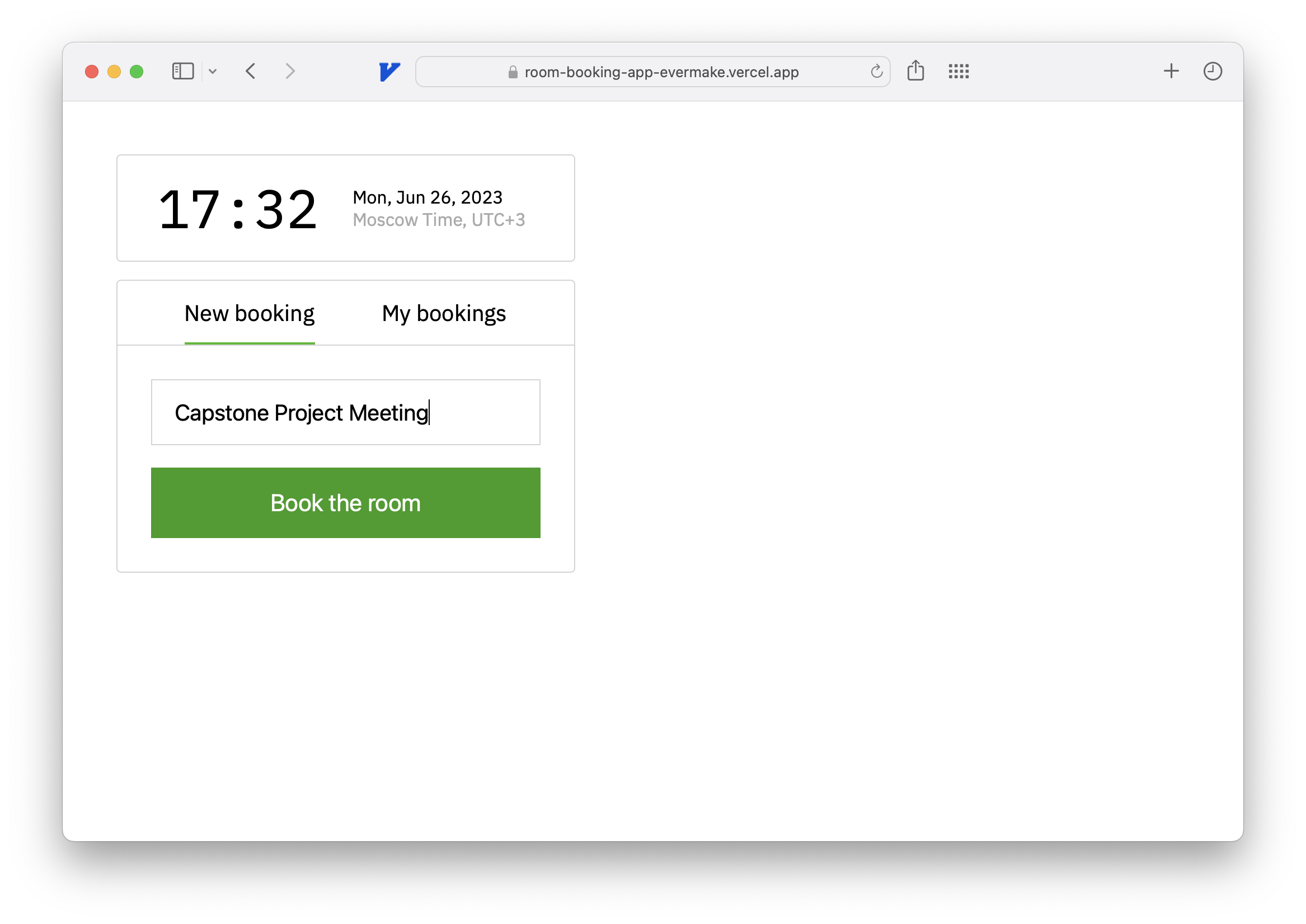
Interactive Map Component: We’ve received a drawing of the university’s third floor and then we manually traced and created a vector image based on the floor plan. Using the exported SVG file from a vector-image editor, an interactive Vue-component for the map was initiated.
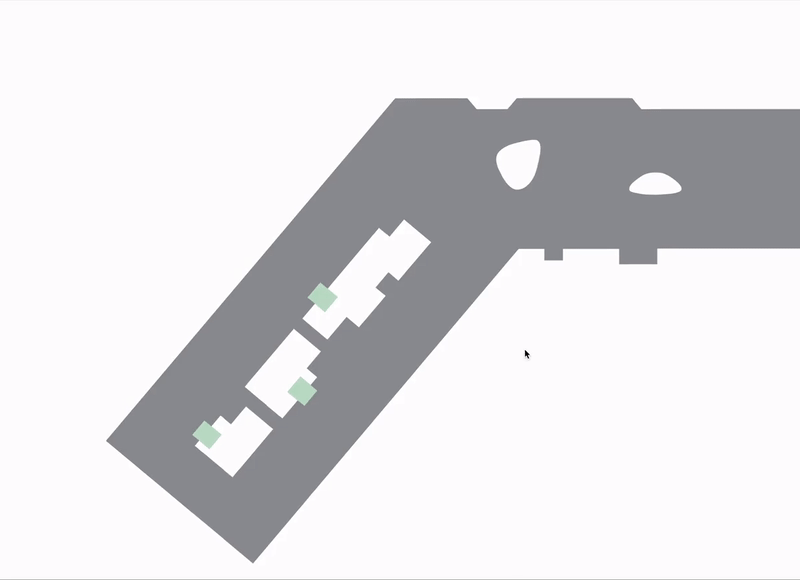
Moving forward, the team will continue refining the UI design and enhancing the interactive map component. Regular collaboration with the backend team will ensure a seamless integration between frontend and backend development efforts.
Backend #
On the backend we had to use Microsoft Outlook API since this is what Innopolis University use. The main challenge is a legacy spaghetti system that makes process of properly extracting data from previous bookings problematic. For example, when we try to extract a room from a given Outlook calendar item there are SIX (probably more) different scenarios in which field and format it could be. But even this isn’t sufficient, since sometimes there is no room specified at all. However, we are constantly improving our system. Currently, it handles almost all of the cases correctly by properly extracting booking organizer, location and time period.
In order to support our backend development, we handled one additional meeting with Andrey Markov and Mikhail Kuskov. The following issues have been discussed:
- Backend Architecture: Discussions were held to define the backend architecture and determine the next steps for development.
- Interface Feedback and Design: Feedback on the interface was received, highlighting the need to improve the process of selecting time slots and rooms.Design enhancements were initiated to address this feedback.
- Microsoft 365 Testing Environment: Mikhail assisted in setting up a dedicated testing environment for Microsoft 365 integration, ensuring the development and testing of APIs without affecting real room bookings.
The meeting with Andrey Markov and Mikhail Kuskov provided valuable insights and guidance for the project, ensuring alignment with objectives and enhancing the overall development process.
Future #
Here’s our tentative tasks for the next 2 weeks:
- Finish development of the map component
- Outline all rooms from the drawing
- Implement Microsoft Outlook API adapter
- Implement authorization system of project’s API
- Bind UI with map
- Bind UI with backend API
Useful Links #
Feedback
Prototype Features
Missing from reports, you should list the feature of the app in the reportUser Interface
This is not a complete UI yet, it’s missing some actions like booking the room. And other features. Why you haven’t completed it yet?The focus was on creating an intuitive and visually pleasing interface. It look good, but not pleasing as I don’t see how to operate with it.
The interactive map is very good!!!
Challenges and Solutions
Good!Next Steps
Good. You should relay think of testing with users (Usability testing)Overall
Good report, you should focus more on development of the fronted now.Grade
4/5Feedback by Moofiy
Week 4 #
Fourth week progress report
External Feedback #
We asked the opinion of our friends and our mentors (Mike Kuskov and Andrei Markov) about our frontend part. Here is a summarized feedback we’ve received:
- The design of the project is described as concise and appealing, with a suitable color scheme and consideration of the key functional requirements. This positive feedback highlights the effectiveness of the design choices made.
- We have taken into account the feedback regarding the mobile version, as we recognize that the majority of users access our service through their phones; and, therefore, we plan to adapt the design to mobile devices in the coming weeks.
Testing and Narrowing the Scope #
This week we focused on improving UI design and frontend part of our application as well. After creating a minimal layout, we created E2E tests, so now and in the future we always be confident that basic functionality in the application works as expected. Here is the demo of our E2E-tests:
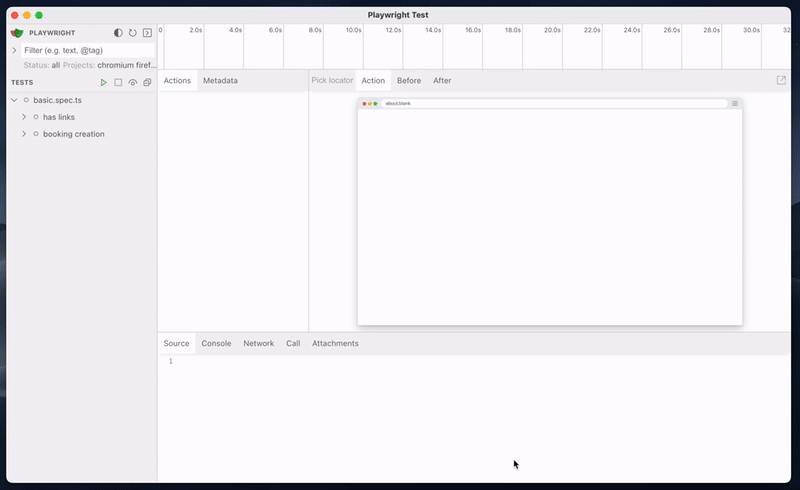
We have not accomplished yet creating tests for our backend, since we are currently actively working on it and modifying the behavior. As soon as we will decide on final API and required behavior we will write unit-tests for the authorization, Outlook adapter and business logic.
This week we also checked our past reports and decided to exclude the calendar functionality, the Telegram Bot API and focus solely on the booking functionality plus the map component.
Iteration and Refinement #
Each week we improve our application design, consulting with frontend team. Here are improvements of the current week:
We did the menu for the current bookings where the user can see all his bookings and also cancel them.
We redesigned all fields in booking menu and now it is the final variant.
We have chosen another size for fonts and formed a set of colors for the whole site.
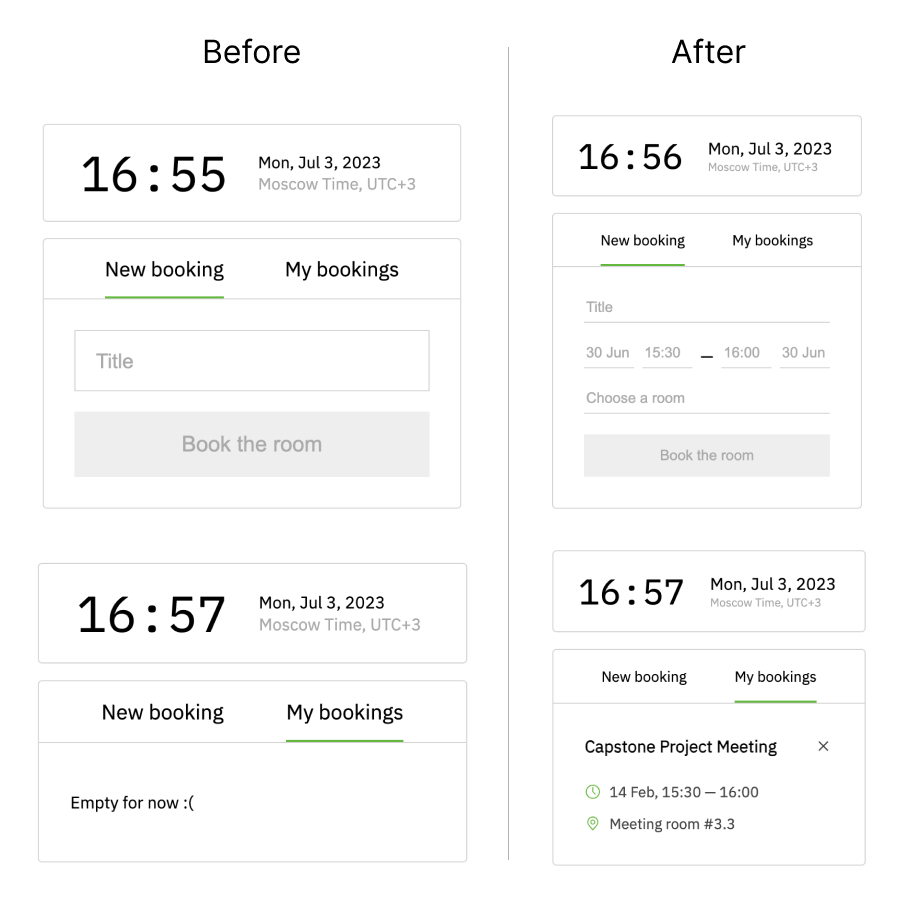
We added the drop-down menu for room choosing. The rooms would be colored according to their availability (green is free, red is occupied and gray is unavailable for booking).

- Also, we designed a pop-up that will be shown next to a room on the map, which will show the brief information about the room and upcoming events in it.

Progress Report #
Progress has been made on the authentication module, as evidenced by the pull request at github.com/Inno-Gang/room-booking/pull/12. Specification is here. There was a misunderstanding between task analysts and its implementer. We made a meeting where studied basic concepts authentication, figured out what is JWT tokens, Access/Refresh tokens and how we should use it in the project.
An Outlook adapter was developed, as indicated by the pull request at github.com/Inno-Gang/room-booking/pull/13. For this task we have studied Outlook API of Innopolis university and parsed it to envelope. However, it is important to note that the adapter has not been tested yet. This week we conducted meeting with Mike Kuskov, one of our customers, and he provided test Outlook API server for testing our backend. We are currently testing our adapter to eventually merge this functionality to main branch of backend development repository.
Design was improved drastically.
Faced problem with the map component: the project encountered difficulties with the map component due to the lack of support and absence of recent development in the only identified JavaScript library (
VueWaypoint). We need the library to attach info about rooms to their pictures.During this week, we met several times to synchronize our progress and to check our priorities.
Feedback
External Feedback
Very Good, but maybe better to follow some kind of User statisifaction metrics like NPS to better utilise this feedback.Also, you should provide links to this servey to proof what you are saying and to get feedback on them.
Testing
Very GoodIteration
Good iteration plan But keep in mindAn iteration plan is essentially the plan for an upcoming iteration. It would typically outline:
- The goals and objectives for the iteration: what the team aims to achieve.
- The features to be developed.
- The tasks needed to develop these features. This might include coding, testing, design tasks, etc.
- Any assumptions or dependencies.
- A timeline for the iteration.
Overall
The report is Amazing!!!.So far this is the best report I graded this week out of 11 teams
Grade: 5/5
Feedback by Moofiy
Week 5 #
Fifth week progress report
Backend #
This week we were focused primarily on the backend part of our project. What we have done:
- Outlook API adapter that simplifies difficulty of Outlook API providing only necessary set of operations for our API implementation
- Regression testing for Outlook API
- Authentication for our API. Currently, we have implemented two types: by
API Key and by Access Token:
- Authentication by API Key. Our service maintains a set of keys that provide an access to room booking functionality. We will use this type of authentication for connecting booking telegram bots, developing by teams from Software Project. API-KEYs will be spread by administrators of our service separately.
- Authentication by Access Token. This type of authentication is dedicated for personal use of booking service. Our frontend will redirect unauthorized users to Innopolis SSO, where they will enter their e-mail with password, and will be redirected to our site. Then our backend will generate an Access Token, using which the frontend will make requests to our API to interact on behalf of the user.
Frontend #
As for frontend, we’ve understood that we are unlikely to have time to make a complete markup so that it looks as we designed before. Especially hard part of UI is inputs and forms, that is why we tried to find some ready, stable and open-source UI-components library for Vue.js framework. We’ve settled on the Naive UI — Vue 3 Component Library that is covered with tests and has a very similar design to what we’ve already created.
We reorganized our project and started to utilize Naive UI and not finished yet, unfortunately. However, with ready components our frontend part development will move faster and we’re going to finish UI part until 12 July and start finalizing logic to work with our backend API.
Now, We Are on the Finish Line. Deadlines Are Close. #
Here is our plan to finish the MVP on the timeline:
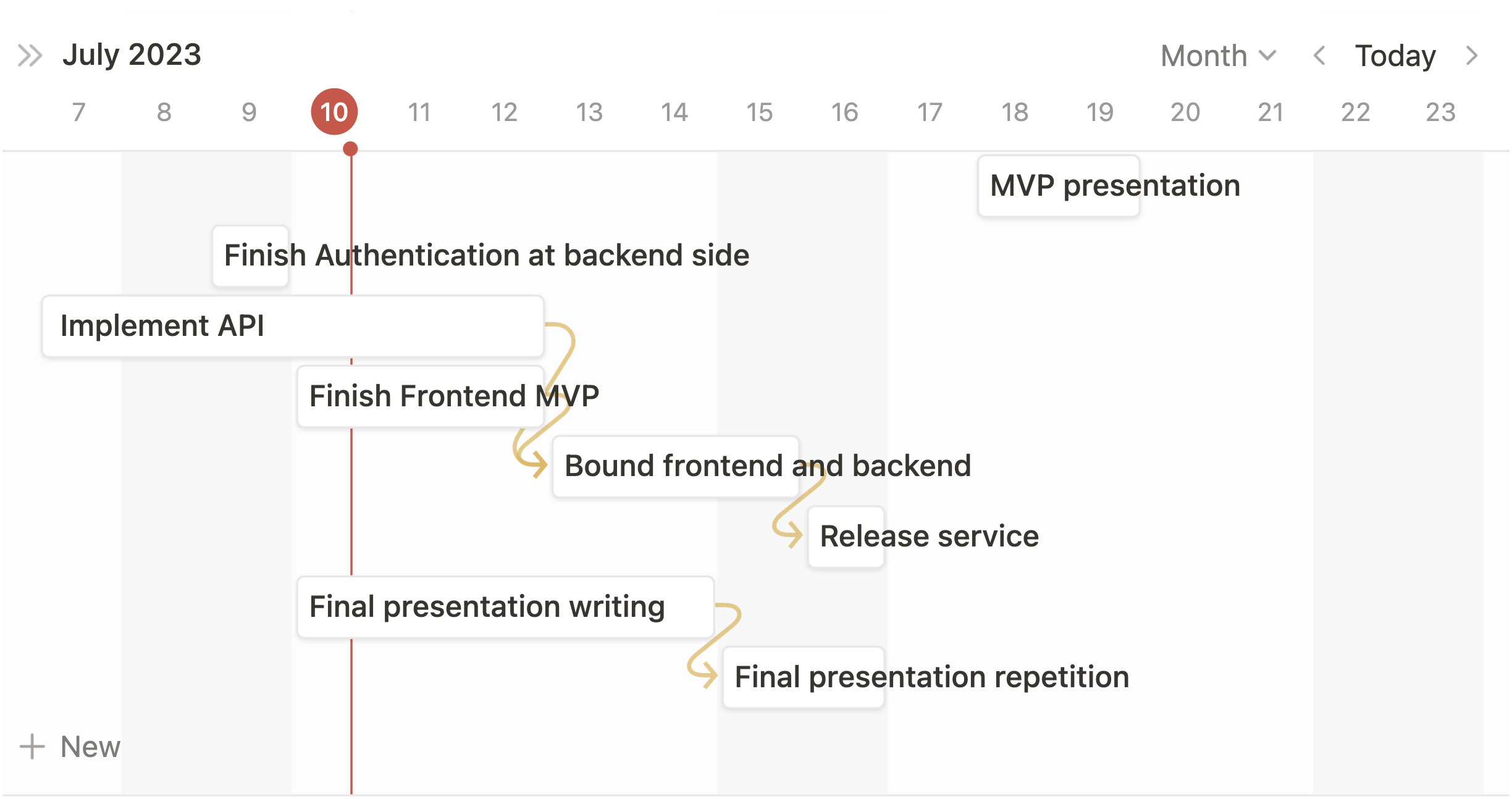
Feedback #
To check the direction of our development we have collected feedback from students in known chats about our application usability. We created a google form where we explained the basic principles of interaction with our graphical interface:
The booking page for the 3rd floor of Innopolis University:- you can set a title, time and room that you prefer to book- when you set time you can see which rooms are free for this time on the map (they are marked with a green color)- by clicking on the room, you can check all scheduled meetings for this room
After this we asked to evaluate out interface numerically and to add any extra comment for suggested improvements. Here is the distribution that we have obtained:
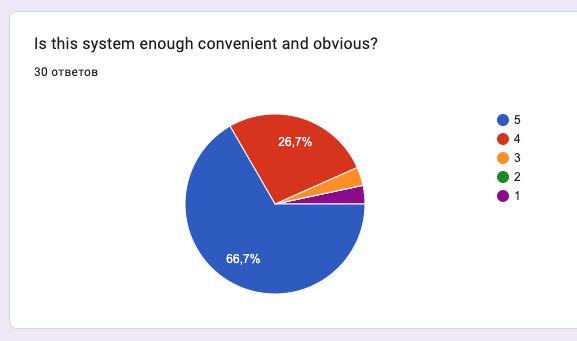
And we got a lot of constructive feedback about possibilities of improvement:
- Do the same as in outlook, we can firstly choose time and then see what is free
- add numbers of rooms for options. And maybe add sighs for dorm direction/entrance to uni :)
- Make the interface of meeting rooms dashboards also simple and convenient as you do for booking. Because sometimes it’s hard to see what is booked in the meeting room at the existing monitor. Excellent UX, thank you for following the university guidelines. Also the map you provided can be improved.
- It already looks like a game changer. Maybe you can a bit modify visualization and add silhouettes of rooms so the separation and location will be more obvious
- Why room names are not sorted (on the screenshot)?
Most things that they highlighted are not part of MVP but we will consider them in near future.
As well, we requested feedback from our stakeholders Andrey and Mike:
Mike Kuskov (translated from Russian): The design looks concise and pretty, the appropriate color scheme is used and the main functional requirements are taken into account)
Andrey Markov (translated from Russian): All I can say is that it looks awesome
Outcomes #
Overall, we are moving in a right direction. Our main goal now is to finish the MVP prototype and release its alpha version for some scope of users.
Roadmap for Further Development #
We are going to move further and support this project after the Capstone Project course finishes. So here is our brief roadmap:
- First, we need to stabilize our project:
- Improve frontend design to be mobile-friendly
- Fix all bugs from existing functionality
- Cover project code with tests
- Make it fault tolerant
- Release it for the whole university
- Next, when project is in use we should provide additional functionality as
received in feedback:
- Fix schedule boards
- Deploy Telegram bot for booking — 1st-year students are already actively working on it and we only will need to couple the bot with our API
- Implement design and functionality we’ve created for TV-screens near the meeting rooms
Feedback
Collecting and documenting feedback
Very good!Feedback analysis
I didn’t see how did you analysis these feedback and how will it reflect in your productRoadmap and enhancement
Very good!Grade: 4.5/5
Feedback by Moofiy
